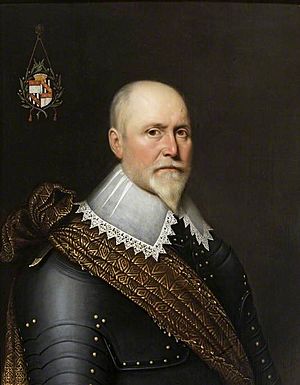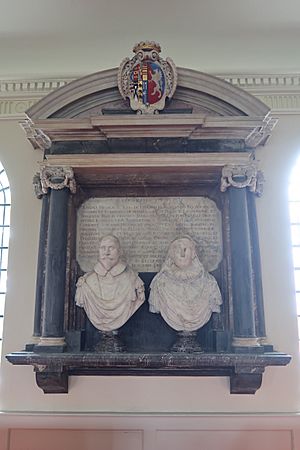Oliver St John, 1st Viscount Grandison facts for kids
Quick facts for kids
Oliver St John, 1st Viscount Grandison
|
|
|---|---|

Oliver St John, 1st Viscount Grandison, 1st Baron Tregoz
|
|
| Lord Deputy of Ireland | |
| In office 1616–1622 |
|
| Preceded by | Arthur Chichester, 1st Baron Chichester |
| Succeeded by | Henry Cary, 1st Viscount Falkland |
| Personal details | |
| Born | 1559 |
| Died | 30 December 1630 |
| Parent |
|
Sir Oliver St John, 1st Viscount Grandison (born 1559 – died 30 December 1630) was an English soldier and politician. He became the Lord Deputy of Ireland, which was like being the King's main representative in Ireland.
Contents
Early Life and Education
Oliver St John was the second son of Nicholas St John. His family lived in places like Lydiard Park in Wiltshire. His mother, Elizabeth, was related to important families. Oliver grew up mostly in Purley.
He studied at Trinity College in Oxford. He earned his first degree in 1578. Since his father didn't plan to leave him much money, Oliver decided to study law. He joined Lincoln's Inn in 1580 to become a lawyer.
Around 1584, a serious incident involving a duel led him to leave England. He then decided to become a soldier.
Military Career Abroad
Oliver St John began his military career serving in other countries. He fought in places like Flanders and France. By 1591, he had become a captain. He led soldiers for Earl of Essex during a battle in Rouen in France.
In 1592, he returned to England. He was chosen to be a member of Parliament for Cirencester. He spoke in Parliament about helping soldiers who were injured. After Parliament ended, he went back to serving as a soldier in the Netherlands. He was part of the battle of Nieuport in 1600.
Service in Ireland
Many experienced English soldiers went to Ireland during Tyrone's rebellion. Oliver St John went there in 1601. He was made a knight in Dublin and given command of 200 men. He played a key role in the siege of Kinsale. During a Spanish attack, he helped defend the English forces, even though he was wounded.
In 1602, he was back in Ireland, leading soldiers in Connacht. He was later suggested for a leadership role in that area. From 1604 to 1607, he was a member of the English Parliament for Portsmouth. In 1605, he became the master of the ordnance in Ireland. This meant he was in charge of military supplies like cannons. He also joined the Irish Privy Council, a group of important advisors.
Oliver St John became a trusted advisor to Arthur Chichester, 1st Baron Chichester, who was then the Lord Deputy of Ireland. In 1608, he helped plan the plantation of Ulster. This was a plan to settle English and Scottish people in Ulster. He traveled through Ulster with Chichester to see the land. He received land grants in Ballymore and Keernan. He suggested that land from Irish leaders who had left should be rented to native Irish people.
Role in Irish Parliament
In 1613, Oliver St John was elected to the Parliament of Ireland for County Roscommon. He was involved in a big disagreement about who should be the Speaker of the Parliament. Two different groups wanted their candidate to be Speaker. St John used his experience from the English Parliament to explain how to vote. The disagreement was so strong that one candidate was physically placed in the Speaker's chair. St John was one of the members who reported this to King James I.
In 1614, he left his role as master of the ordnance.
Becoming Lord Deputy of Ireland
In 1615, Oliver St John was made Vice-Admiral of Connaught for life. This role involved overseeing naval matters in that region.
On 2 July 1616, Oliver St John was appointed Lord Deputy of Ireland. He officially took up the role on 30 August. His appointment was partly because he was connected to the Duke of Buckingham, a very powerful person at court. During his time as Lord Deputy, he continued to encourage the settlement of English and Scottish people in Ireland. He oversaw new settlements in County Longford in 1618 and County Leitrim in 1619.
His strict actions against certain religious groups made him unpopular with some people. Many of his advisors wanted him to be removed from his position. Even though King James I praised him, St John was eventually told to hand over his power in April 1622. He left Ireland in May.
Later Life and Honors
Even after leaving Ireland, Oliver St John remained important at court. In 1622, he joined the English Privy Council. In 1623, he was given the title of Viscount Grandison of Limerick in Ireland. In 1625, he became the Lord High Treasurer of Ireland, managing the country's money. In 1626, he was given another title, Baron Tregoz of Highworth, Wiltshire, in England.
In 1624, St John was part of the Council of War, which advised on military matters. He also took an interest in foreign affairs. In 1627, he bought land in Wandsworth and Battersea, where he had lived since 1600.
His health began to decline. After visiting Ireland in 1630 to sort out his properties there, he returned to Battersea. He passed away on 30 December 1630 and was buried there in January 1631.
Family Life
Oliver St John married Joan Roydon. She was the widow of Sir William Holcroft. They did not have any children together. Joan was buried in Battersea in March 1631.
After Oliver St John's death, his title of Baron Tregoz ended because he had no children. His lands in Wandsworth and Battersea went to his nephew, Sir John St John. His title of Viscount Grandison passed to another nephew, William Villiers.
Images for kids




